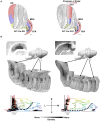Theta variation and spatiotemporal scaling along the septotemporal axis of the hippocampus
- PMID: 25852496
- PMCID: PMC4360780
- DOI: 10.3389/fnsys.2015.00037
Theta variation and spatiotemporal scaling along the septotemporal axis of the hippocampus
Abstract
Hippocampal theta has been related to locomotor speed, attention, anxiety, sensorimotor integration and memory among other emergent phenomena. One difficulty in understanding the function of theta is that the hippocampus (HPC) modulates voluntary behavior at the same time that it processes sensory input. Both functions are correlated with characteristic changes in theta indices. The current review highlights a series of studies examining theta local field potential (LFP) signals across the septotemporal or longitudinal axis of the HPC. While the theta signal is coherent throughout the entirety of the HPC, the amplitude, but not the frequency, of theta varies significantly across its three-dimensional expanse. We suggest that the theta signal offers a rich vein of information about how distributed neuronal ensembles support emergent function. Further, we speculate that emergent function across the long axis varies with respect to spatiotemporal scale. Thus, septal HPC processes details of the proximal spatiotemporal environment while more temporal aspects process larger spaces and wider time-scales. The degree to which emergent functions are supported by the synchronization of theta across the septotemporal axis is an open question. Our working model is that theta synchrony serves to bind ensembles representing varying resolutions of spatiotemporal information at interdependent septotemporal areas of the HPC. Such synchrony and cooperative interactions along the septotemporal axis likely support memory formation and subsequent consolidation and retrieval.
Keywords: dorsoventral axis; entorhinal cortex; hippocampus; locomotor activity; sensorimotor integration; septotemporal axis; theta oscillations.
Figures





Similar articles
-
Septotemporal variation in dynamics of theta: speed and habituation.J Neurophysiol. 2011 Jun;105(6):2675-86. doi: 10.1152/jn.00837.2010. Epub 2011 Mar 16. J Neurophysiol. 2011. PMID: 21411562
-
Theta dynamics in rat: speed and acceleration across the Septotemporal axis.PLoS One. 2014 May 19;9(5):e97987. doi: 10.1371/journal.pone.0097987. eCollection 2014. PLoS One. 2014. PMID: 24842406 Free PMC article.
-
Ketamine disrupts theta synchrony across the septotemporal axis of the CA1 region of hippocampus.J Neurophysiol. 2013 Jan;109(2):570-9. doi: 10.1152/jn.00561.2012. Epub 2012 Oct 31. J Neurophysiol. 2013. PMID: 23114214
-
Hippocampus as comparator: role of the two input and two output systems of the hippocampus in selection and registration of information.Hippocampus. 2001;11(5):578-98. doi: 10.1002/hipo.1073. Hippocampus. 2001. PMID: 11732710 Review.
-
Modulation of hippocampal neuronal network oscillations by α7 nACh receptors.Biochem Pharmacol. 2015 Oct 15;97(4):445-453. doi: 10.1016/j.bcp.2015.06.031. Epub 2015 Jul 21. Biochem Pharmacol. 2015. PMID: 26206189 Review.
Cited by
-
Movement Enhances the Nonlinearity of Hippocampal Theta.J Neurosci. 2016 Apr 13;36(15):4218-30. doi: 10.1523/JNEUROSCI.3564-15.2016. J Neurosci. 2016. PMID: 27076421 Free PMC article.
-
Theta oscillations optimize a speed-precision trade-off in phase coding neurons.PLoS Comput Biol. 2024 Dec 2;20(12):e1012628. doi: 10.1371/journal.pcbi.1012628. eCollection 2024 Dec. PLoS Comput Biol. 2024. PMID: 39621800 Free PMC article.
-
Flexible theta sequence compression mediated via phase precessing interneurons.Elife. 2016 Dec 8;5:e20349. doi: 10.7554/eLife.20349. Elife. 2016. PMID: 27929374 Free PMC article.
-
Adapting hippocampus multi-scale place field distributions in cluttered environments optimizes spatial navigation and learning.Front Comput Neurosci. 2022 Dec 12;16:1039822. doi: 10.3389/fncom.2022.1039822. eCollection 2022. Front Comput Neurosci. 2022. PMID: 36578316 Free PMC article.
-
Behavior-Dependent Activity and Synaptic Organization of Septo-hippocampal GABAergic Neurons Selectively Targeting the Hippocampal CA3 Area.Neuron. 2017 Dec 20;96(6):1342-1357.e5. doi: 10.1016/j.neuron.2017.10.033. Epub 2017 Nov 30. Neuron. 2017. PMID: 29198757 Free PMC article.
References
Publication types
LinkOut - more resources
Full Text Sources
Other Literature Sources

